
Vol. 14 No. 3 |
Winter 2004-05 |
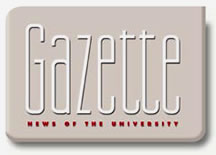 LORI
HACKING SCHOLARSHIP
LORI
HACKING SCHOLARSHIP
Thousands of dollars have been contributed to the Lori Hacking Memorial Fund by relatives, friends of Lori, and individuals from across the nation, who have been impressed and moved by the story of her accomplished life and untimely death. Lori's family has donated the proceeds of this fund to the University to establish a scholarship in her memory—the Lori Kay Soares Hacking Memorial Scholarship.
In September, Lori's mother, Thelma Soares, appeared on The Oprah Winfrey Show to talk about her ordeal, which prompted Winfrey to pledge $50,000 to the scholarship fund. The University has raised $160,000 thus far.
 The
endowed scholarship—to be awarded to a female student enrolled in
the U's David Eccles School of Business—will assist a disadvantaged
woman who has experienced abuse, financial hardship, family challenges
or other difficult life circumstances.
The
endowed scholarship—to be awarded to a female student enrolled in
the U's David Eccles School of Business—will assist a disadvantaged
woman who has experienced abuse, financial hardship, family challenges
or other difficult life circumstances.
Applicants must be fulltime students who have been admitted to the School
of Business prior to their junior year and can demonstrate any of the
above hardships. They must be in good standing at the U and have a minimum
grade point average of 3.0. For additional information about the scholarship,
contact Carolyn Buma at (801) 5815255 or visit www.ugive.utah.edu
or http://remberlori.com.
Hacking received many awards while a student at the U and was described by one of her professors, Susan A. Chesteen, as "a person who strengthened the academic atmosphere of our program in significant ways. She was a gentle person of high integrity and compassion."
Additional donations to the fund will ensure that it can provide scholarships for two students each year. Contributions can be made online at www.ugive.utah.edu or by mailing them to: Lori Kay Soares Hacking Scholarship Fund, University of Utah Development Office, 201 Presidents Circle, Room 302, Salt Lake City, UT 84112.
GREEK THEATRE RETURNS TO ITS ORIGINS
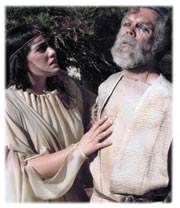 The
University's Classical Greek Theatre has been a campus and community favorite
for many years. (See Continuum, Fall 2000, "The Gods Must
Be Crazy," by Mary Dickson.) But this past summer, its appeal spread
beyond the borders of the campus, Utah, and the United States to Greece,
where it all began.
The
University's Classical Greek Theatre has been a campus and community favorite
for many years. (See Continuum, Fall 2000, "The Gods Must
Be Crazy," by Mary Dickson.) But this past summer, its appeal spread
beyond the borders of the campus, Utah, and the United States to Greece,
where it all began.
In the spring of 2004, the theatre department's cast and crew—12 students and three faculty members—performed Oedipus at Colonus for the Athens Centre Theater Festival, in the ancient city of Athens and on the island of Spestis. Interim department chair Richard Scharine (see Continuum, Fall 1998, "Theater in the Round," by Carl Sederholm) performed the title role of Oedipus. Prof. Sandra Shotwell directed the play, and Prof. Jim Svendsen, who helped revive Greek Theatre at the U almost 35 years ago, completed the group.
NEW RESEARCH ON AUTISM
On July 19, 2004, the National Alliance for Autism Research (NAAR) began
the NAAR Autism Genome Project, the largest such study ever conducted
for the purpose of finding the genes associated with inherited risk for
autism. Over a sixmonth period, about 170 of the world's leading genetics
researchers, including the University of Utah School of Medicine, are
pooling their resources and using a new methodology, the DNA microarray,
to scan the human genome in the search for the genetic causes of autism.
The NAAR project expects initial results from the DNA array scan by early
2005. This is one of the first times DNA microarray technology is being
used on such a large scale in the search for genes associated with autism.
OLLI, FOR LIFELONG LEARNING
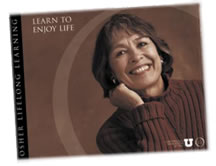 The
newly formed University of Utah Osher Lifelong Learning Institute (OLLI)
began offer ing courses in its fall session to individuals age 50 and
older interested in enriching educational experi ences. OLLI is funded
by an initial grant of $100,000 from the Bernard Osher Foundation and
anticipates qualifying for a $1 million endowment from the foundation
as early as 2006.
The
newly formed University of Utah Osher Lifelong Learning Institute (OLLI)
began offer ing courses in its fall session to individuals age 50 and
older interested in enriching educational experi ences. OLLI is funded
by an initial grant of $100,000 from the Bernard Osher Foundation and
anticipates qualifying for a $1 million endowment from the foundation
as early as 2006.
OLLI is a membership program in which subscribers pay a $400 fee to take up to three noncredit classes per term (additional courses may be added for $50 each). The fee enables members to participate in many additional University-related benefits, such as Field House privileges, private tours and lectures, and weekly screenings of Hollywood feature fi lms.
Three six-week terms will be offered annually. OLLI's spring 2005 session begins March 28 and runs through May 5. Summer session begins May 23 and continues through July 1. Distinguished emeritus faculty and scholars will teach courses, which will be conducted weekday mornings at Fort Douglas on the U's upper campus. The curriculum will focus on five areas: health and wellbeing; effective asset management for mature citizens; social interaction and community and civic engagement; intellectual explorations; and the tools of technology.
For additional information about the Institute, call Anne Peterson at (801) 581-7973 or visit www.continue.utah.edu/osher.
AMERICA'S BEST COLLEGES
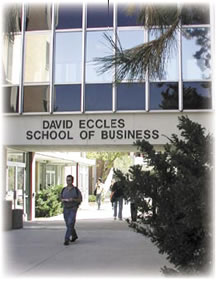 The
University of Utah continues to climb in its rank ing in the U.S.
News & World Report guide to "America's Best Colleges."
(See Continuum, Winter 2000, "The Rankings Game," by
Suzanne Dean.) In the 2005 edition, the U ranks 111th out of more than
1,400 colleges and universities surveyed, moving up seven spots since
the last survey. This ranking is determined annually based on a complicated
system of peer assessments and statistical data. When private universities
are factored out of the mix, Utah ranks even higher—54th among public
institutions, tying with Florida State.
The
University of Utah continues to climb in its rank ing in the U.S.
News & World Report guide to "America's Best Colleges."
(See Continuum, Winter 2000, "The Rankings Game," by
Suzanne Dean.) In the 2005 edition, the U ranks 111th out of more than
1,400 colleges and universities surveyed, moving up seven spots since
the last survey. This ranking is determined annually based on a complicated
system of peer assessments and statistical data. When private universities
are factored out of the mix, Utah ranks even higher—54th among public
institutions, tying with Florida State.
The U's David Eccles School of Business undergraduate program placed 48th in the nation this year, once again moving into the top 50, from which it had fallen in the 2002 survey—the last time this category was included.
Business School Dean Jack Brittain praises the hard work being done by the school's faculty in reaching this post. "It's good to know that the quality of education students receive at the David Eccles School is being recognized nationally. We have improved many of our programs over the past couple of years, and I believe the move ment up the rankings is well deserved," he says.
Utah's undergraduate engineering program also moved up seven spots this year to 60th best in the country for schools whose highest degree is a doctorate. The U's College of Engineering is nationally known for the many accomplishments of its graduates and faculty who have founded such noted companies as TRW, Evans & Sutherland, SGI, Netscape, WordPerfect, Novell, Adobe Systems, Little America and Pixar.
Service Learning is another area in which Utah ranks among the best. U.S. News & World Report describes service learning as a program that emphasizes volunteering in the community as an instructional strategy—and is a requirement of students' coursework.
And finally, a relatively fatter pocketbook is indicated for U students: This year's rankings place Utah among national universities whose students accumulate the least amount of debt before graduation. The figures indicate that 42 percent of U students will acquire some amount of debt, with the average student accruing $12,400 in loans.
U GETS A NEW ENGINEERING BUILDING
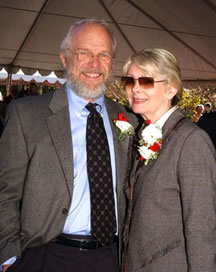 |
John
and Marva Warnock. Photo by Steven Leitch |
Groundbreaking ceremonies for the University of Utah's new John E. and Marva M. Warnock Engineering Building took place in October at the construction site southeast of the Merrill Engineering Building.
Program speakers included John Warnock BS'61 MS'64 PhD'69, cofounder and cochairman of Adobe Systems Inc.; Shane V. Robison, executive vice president and chief technology and strategy officer for HP; and University of Utah President Michael K. Young.
The $28 million building—named for U of U alumni John and Marva (BS'66) Warnock, in recognition of more than $9 million in total contributions to the University—was funded through $15 million in state building bonds and $13 million in private funds. In addition to the Warnocks' cornerstone gift, the building campaign attracted more than 500 individual gifts from engineering alumni and friends.
The heart of the building will be the Michael O. Leavitt Student Learning Center. With computerbased classrooms and teaching labs, quiet study areas and a cafe, the center will provide the academic home of the engineering campus. The center honors former Gov. Leavitt's special commitment to engineering education and technology development.
Among the Warnock Engineering Building's hightech facilities will be the Scientific Computing and Imaging (SCI) Institute, where faculty and students are dedicated to creating new computing techniques, tools and systems for solving problems that affect human life.
Marva Warnock is a designer and partner with Marsh Design in Palo Alto, Calif. John Warnock is cochairman of the board of Adobe Systems, Inc., a company he cofounded in 1982 with Charles Geschke. Warnock pioneered the development of worldrenowned graphics, publishing, Web and electronic document technologies that revolutionized publishing, design and visual communication. He holds six patents and is one of the world's most respected software innovators.
The building is expected to be completed fall 2006. Architects for the project are Anshen & Allen of San Francisco with Prescott Muir of Salt Lake City. Jacobsen Construction is the general contractor.
RESEARCH FUNDING TOPS $300 MILLION
 Utah
Gov. Olene Walker, along with President Michael K. Young of the University
of Utah and President Kermit L. Hall of Utah State University, acknowledged
combined record research funding revenues of nearly a half billion dollars
this past fiscal year at the two universities. Recognition of these funds
emphasizes that the state's public research universities significantly
benefit Utah's economy, as well as its system of higher education.
Utah
Gov. Olene Walker, along with President Michael K. Young of the University
of Utah and President Kermit L. Hall of Utah State University, acknowledged
combined record research funding revenues of nearly a half billion dollars
this past fiscal year at the two universities. Recognition of these funds
emphasizes that the state's public research universities significantly
benefit Utah's economy, as well as its system of higher education.
During fiscal year 2004, which ended June 30, the U of U surpassed the
$300 million mark for the first time, receiving more than $309 million
in research grants, fellowships for graduate students and financial aid
for undergraduates—an eight percent increase over the previous year.
Virtually all of this money came from sources outside Utah. Consequently,
the U ranked 27th nationally among 199 major public research universities,
a remarkable feat given the state's comparatively small population. During
this same time period, Utah State University received a record $186 million,
an 18 percent increase over the previous year. Both universities have
more than doubled their research revenues in the last decade.
IN MEMORIAM
Orlando Cuellar, 70, one of the University of Utah's first Latino professors. He joined the U's biology department in 1972 and retired in 1992. He was active in Salt Lake City's Latino community and served as president of the Centro Civico Mexicano in 1992.
Elizabeth Rhodes Dalgliesh, 100, widow of the late history professor W. Harold Dalgliesh, for the past 71 years was active at the U, where she taught, worked and was copy editor of the Western Political Quarterly for 51 years. She was an avid fan of the U basketball team. Rhodes Dalgliesh was ordained a priest in the Episcopal Church at the age of 82.
Lee E. Teitelbaum, 63, law professor and former dean of the S.J. Quinney School of Law. He was author or coauthor of seven books, including a case book used in many of the nation's law schools today, Children, Parents, and the Law: Public and Private Authority in the Home, Schools, and Juvenile Courts.